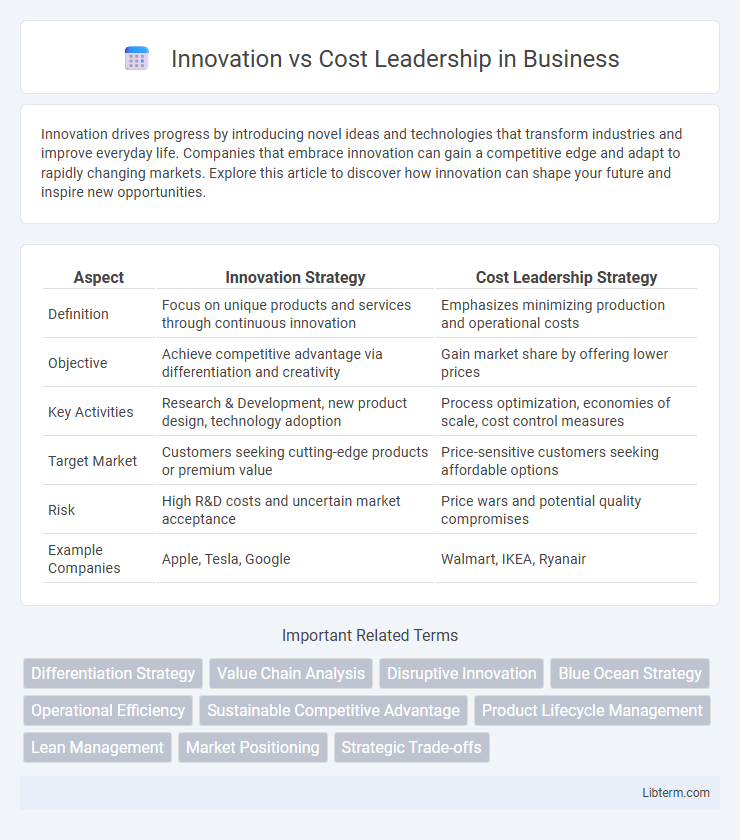Innovation drives progress by introducing novel ideas and technologies that transform industries and improve everyday life. Companies that embrace innovation can gain a competitive edge and adapt to rapidly changing markets. Explore this article to discover how innovation can shape your future and inspire new opportunities.
Table of Comparison
| Aspect | Innovation Strategy | Cost Leadership Strategy |
|---|---|---|
| Definition | Focus on unique products and services through continuous innovation | Emphasizes minimizing production and operational costs |
| Objective | Achieve competitive advantage via differentiation and creativity | Gain market share by offering lower prices |
| Key Activities | Research & Development, new product design, technology adoption | Process optimization, economies of scale, cost control measures |
| Target Market | Customers seeking cutting-edge products or premium value | Price-sensitive customers seeking affordable options |
| Risk | High R&D costs and uncertain market acceptance | Price wars and potential quality compromises |
| Example Companies | Apple, Tesla, Google | Walmart, IKEA, Ryanair |
Understanding Innovation and Cost Leadership
Innovation involves developing new products, services, or processes that deliver unique value and differentiate a company from competitors, often leading to premium pricing and market leadership. Cost leadership focuses on achieving the lowest operational costs to offer competitive pricing, targeting a broad market to maximize sales volume and profitability. Understanding the balance between innovation and cost leadership enables businesses to choose strategic paths that align with their resources, market demands, and long-term growth objectives.
Key Differences Between Innovation and Cost Leadership
Innovation strategy emphasizes developing unique products or services through advanced technology and creative processes, driving differentiation and market disruption. Cost leadership focuses on minimizing operational and production expenses to offer competitive pricing while maintaining profitability. The core difference lies in innovation prioritizing value creation through novelty, whereas cost leadership targets efficiency and scale to achieve cost advantages.
Advantages of an Innovation Strategy
An innovation strategy drives competitive advantage by fostering unique product development and enabling market differentiation, leading to increased customer loyalty and higher profit margins. It encourages continuous improvement and adaptation to emerging trends, ensuring long-term business sustainability in dynamic markets. Companies pursuing innovation can capture new market segments and create barriers for competitors, reinforcing their industry leadership.
Benefits of a Cost Leadership Approach
Cost leadership enables businesses to offer products or services at the lowest price point in the industry, attracting price-sensitive customers and increasing market share. Achieving economies of scale and operational efficiencies lowers production and operational costs, thereby maximizing profit margins even with competitive pricing. This approach also provides a strong defense against competitors, as cost leaders can sustain profitability during price wars and economic downturns.
Risks Associated with Innovation
Innovation involves significant financial investment and uncertain returns, making it inherently risky compared to cost leadership strategies that prioritize efficiency and standardized processes. High R&D expenses and the potential for product failure can lead to substantial losses and impact a company's market position. Firms pursuing innovation must also navigate rapid technological changes and evolving consumer preferences, increasing the complexity and unpredictability of product development cycles.
Challenges in Achieving Cost Leadership
Achieving cost leadership faces significant challenges such as maintaining low operational costs while ensuring product quality and customer satisfaction. Companies often struggle with balancing economies of scale against the risk of reduced innovation and flexibility in response to market changes. Intense competition and fluctuating raw material prices further complicate sustaining cost advantages in the long term.
Successful Examples of Innovation in Business
Apple's continuous innovation in product design and user experience, exemplified by the iPhone and MacBook, has solidified its position as a market leader while commanding premium prices. Tesla revolutionized the automotive industry through cutting-edge electric vehicle technology and sustainable energy solutions, capturing significant market share despite higher production costs. Amazon's relentless innovation in logistics, cloud computing, and customer-centric services has driven growth and profitability, illustrating the power of innovation to create competitive advantage beyond cost leadership.
Notable Cost Leadership Success Stories
Walmart exemplifies cost leadership through its relentless focus on supply chain efficiency and economies of scale, enabling it to offer consistently low prices. Southwest Airlines maintains cost leadership by optimizing operational processes and leveraging a single aircraft model, significantly reducing maintenance and training expenses. IKEA achieves cost leadership by integrating flat-pack furniture design with global sourcing strategies, minimizing costs while maintaining product quality and affordability.
Choosing the Right Strategy for Your Business
Selecting between innovation and cost leadership hinges on aligning your business strategy with market demands and competitive dynamics. Emphasizing innovation allows companies to differentiate through unique products and services, driving higher margins and customer loyalty. Cost leadership focuses on operational efficiency and economies of scale to offer competitive pricing, appealing to price-sensitive markets and maximizing volume sales.
Balancing Innovation and Cost Leadership for Competitive Advantage
Balancing innovation and cost leadership involves integrating cutting-edge product development with efficient cost management to achieve sustainable competitive advantage. Companies that invest in research and development while streamlining operations can deliver unique value propositions at competitive prices. Leveraging advanced technologies and process improvements enables firms to differentiate their offerings without sacrificing cost efficiency.
Innovation Infographic

 libterm.com
libterm.com